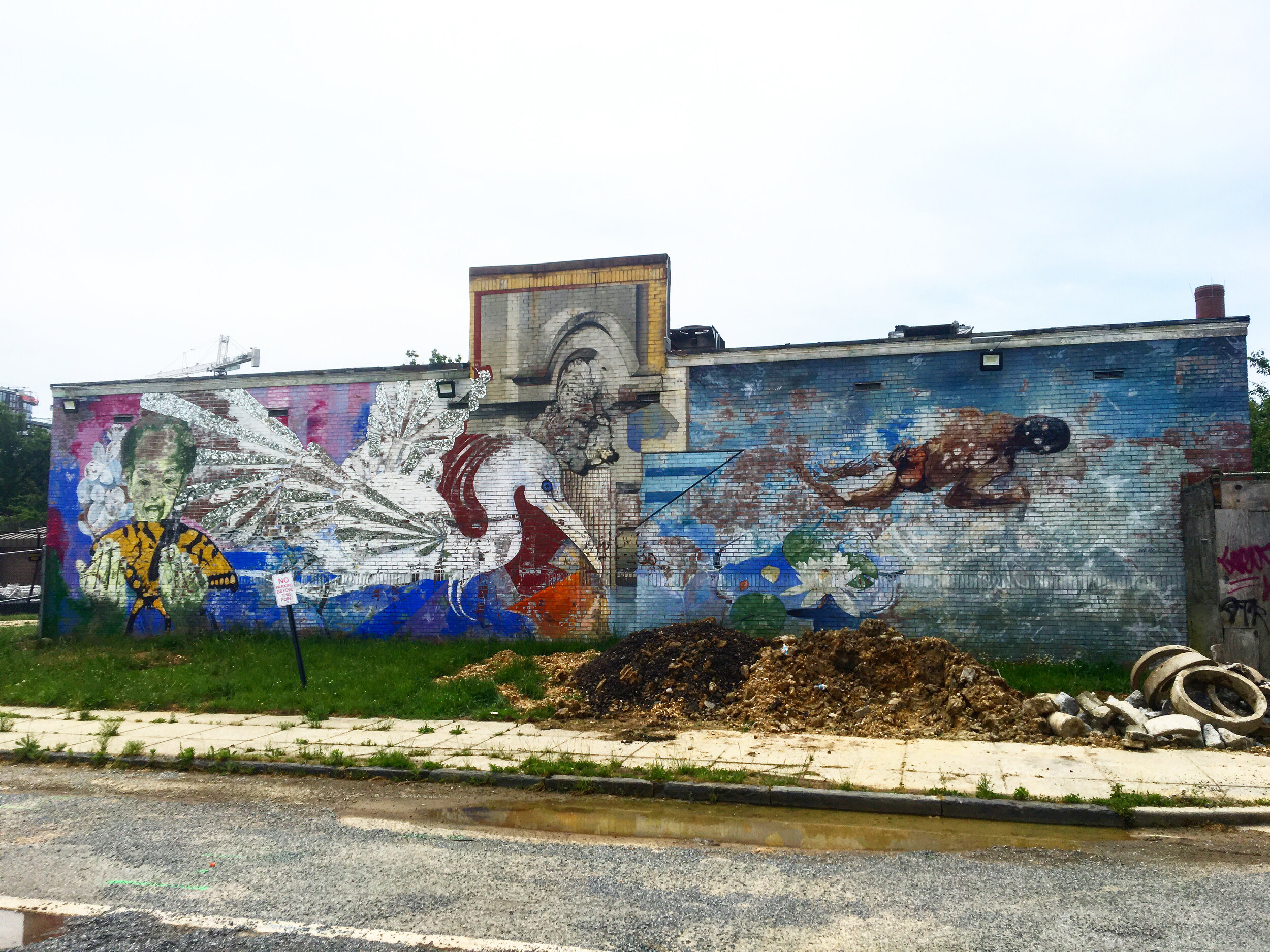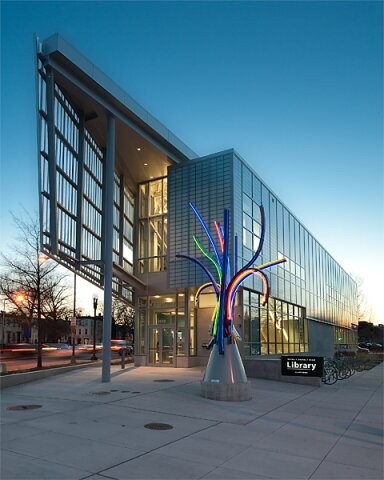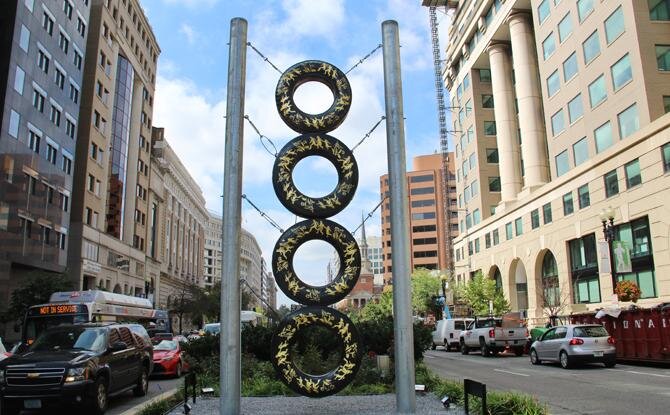While the majority of the art world is on lockdown, the vibrant public artwork around D.C. remains accessible, so if you’re craving some of the color, style, and culture that make up the D.C. art scene, these works are for you. Whether you are exploring virtually or in person, these ten pieces demonstrate the creativity and community present in the city outside of the fine arts world.
In responding to lockdown sanctions brought on by the pandemic, the art world as we know it has been placed on pause, with museums and galleries shutting down and moving their resources online. While this new digital era will undoubtedly foster positive discussion in terms of the accessibility of artistic resources, artists and art patrons around the world have felt a sense of loss as these institutions remain closed to the public. Nowhere is this loss more apparent than in D.C., where the free Smithsonian institutions welcome thousands of museum-goers per year, and where galleries and community arts spaces seem to thrive in every nook and cranny of the city. However, it is still possible to visit the vibrant array of public artworks that provide rich backdrops to communities populating the D.C. area. These works play a significant role in the infrastructure, community engagement, and cultural identity of D.C. neighborhoods. Taking a tour of D.C. public art, whether virtually or in person, is a great way to explore the city during lockdown and get to know some artists who have shaped its landscape (however, when exploring these works in person, please take care to follow all recommended safety protocols like social distancing and wearing a mask).
I have assembled a list of ten public artworks I find particularly compelling. Some of these works you may pass everyday; some require you to search for them. My focal point while assembling this list was to portray the variety of street art available in D.C.; a variety of mediums, subject matter, style, artist background, and D.C. neighborhood. Were you to take the full tour, I would hope you would be able to travel all throughout D.C. and explore the myriad of ways public art can enrich and uplift communities.
Before presenting a list of commissioned murals and sculptures, I would be remiss to neglect D.C.’s rich history of graffiti art, primarily created by the city’s historically black communities. Though sanctioned public art is a powerful tool for representing citizens’ voices, I would also argue that graffiti has played an essential role in allowing marginalized artists to self-identify and raise up their voices. The arguments surrounding graffiti in D.C. have a difficult history, and any graffiti that does appear is usually swiftly taken down. However, I urge you, as you make your way through this list, to keep your eyes peeled for other street artists whose voices have often gone unnoticed by the fine arts world. Due to graffiti’s ephemeral nature, I cannot recommend specific pieces, but I find no matter where I go in D.C. I see evidence of the artistic voices that contribute to the canvas of the city.
1. ‘Edgewood to the Edge of the World’ (2009)
Artists: Chor Boogie, Alicia Cosnahan (DECOY), Joshua Mays, Maxx Moses (Pose 2) and Quest Skinner, with forty community volunteers
Location: 680 Rhode Island Ave NE
Street artists Chor Boogie, Alicia Cosnahan (DECOY), Joshua Mays, Maxx Moses (Pose 2) and Quest Skinner, along with forty young community members, worked together to create this sprawling 700-foot-long mural, located behind the Rhode Island Ave. Shopping Center and partially visible from the metro, in 2009. This mural was commissioned by the D.C. Commission on the Arts and Humanities and was coordinated through Open Walls DC and Murals DC. Graffiti taggers were welcomed to contribute to the mural in a safe and patient creative environment, and added to it periodically after it was finished, which allowed the work to evolve and expand until it became what it is now: a cacophony of artistic voices coming together to symbolize the strength and vibrancy of the Edgewood community. Over a decade later, some of the colors have faded, but new additions to the wall over the years have allowed it to evolve with the landscape of Edgewood.
2. Randall Mural-‘Mosaic Murals of Child and Bird’ (2002)
Artists: G. Byron Peck, Cheryl Foster
Location: 65 I St SW
This mural is a whimsical collaboration between two prolific D.C. area artists: G. Byron Peck and Cheryl Foster, who were assisted by eight students in completing the work. G. Byron Peck’s work is ubiquitous in D.C.: his enigmatic Elizabeth Taylor mural peers out at the streets of Adams Morgan, and his Columbia Heights Community Mural welcomes all to the neighborhood. His work can be characterized by vibrant colors, photo-realistic faces, and a strong use of symbolism. Cheryl Foster’s work can be found throughout the D.C. area as well; she has created intricate, mixed-media mosaic pieces for locations like Arlington Cemetery and National Harbor. The Randall Mural, named for the abandoned school chosen as its location, has since faded since Peck and Foster first envisioned it in 2002, but the intriguing details of the mural are still visible. The two artists’ styles intertwine in a sort of dreamscape. The mosaic elements on the bird’s feathers catch the light and sweep the viewer’s eye across the composition, from the jubilant child presenting the audience with a butterfly, back through the piece to the joyful swimmer drenched in sunlight. The mural plays with perspective, as the column in the center seems to recede into the background, contrasting with the large butterfly, which appears to burst off the wall. Any sign of the original building facade simply adds another layer of depth to this rich, joyful scene.
Art on the windows of the Randall School, advertising for the new museum.
In walking around the back of the school to access the mural, you may come across a sign advertising the building’s next phase; it is being transformed into a contemporary art museum to accompany a new housing and retail development in the area. This was very interesting to me, as it is exciting to hear about a new D.C. art museum, but it also marks the Randall mural’s expiration date, and raises questions about how the neighborhood will be transformed with this new development. I am glad I got to see this mural in all its fading glory, and I recommend making the trip before things change, as the city’s landscape tends to do.
3. Culture House DC. (2012)
Artist: HENSE
Location: 700 Delaware Ave SW
Culture House D.C. is conveniently situated just a few yards away from the Randall Mural, so you get to see two stunning works for the price of one trip. The Seussian building, formerly a Baptist church, has hundreds of years of history that culminates in its status as a community arts space that is itself a work of art. Situated between what is perhaps the sleepiest cul-de-sac in D.C. and an abandoned lot, Culture house seems to spring up out of nowhere, its psychedelic walls almost overwhelmingly joyful. Renowned Atlanta-based muralist HENSE decorated the exterior of Culture House, and the building’s bright colors and organic shapes embody his playful style. The undulating lines, candy-colored blobs, and whimsical dots transform and elevate the church’s Gothic architecture in a way that is extremely striking. I also noticed when I went to see it that the space has been tagged multiple times, undoubtedly due to its closure during lockdown. I felt that the graffiti added yet another layer of art and history to this already complex space.
4. ‘Vivace’ (2010)
Artist: Craig Kraft
Location: Watha T. Daniel Shaw Neighborhood Public Library, 1630 7th St. NW
Photo via dclibrary.org
Craig Kraft, a prolific neon artist who was a Shaw resident for 13 years, created this exuberant sculpture as an homage to the neighborhood’s growth, as well as the area’s rich history of jazz music. To Kraft, the medium was essential to conveying the theme; in his artist statement he notes: “Neon light and Jazz are a natural pair as they both come alive and are most vibrant at night. In jazz clubs throughout the world Jazz has traditionally been bathed in the glow of neon light. The unique site of the Watha T. Daniel Library offers an ideal stage to showcase both the historical significance of Jazz and the connections to neon as a sculptural medium.” The sculpture emulates the flow of jazz music in that it depicts an explosion of different colors and lines all stemming from the same powerful source. Its ordered chaos evokes a frenetic, yet fluid, energy. In visiting this artwork, it is important to note its location; the Watha T. Daniel Shaw Library is itself a work of art. Designed by Peter Cook (AIA, NOMA), the library’s sleek triangular layout and glass facade allow it to also glow from within, making both the library and the sculpture outside it a must-see during an evening stroll around Shaw.
5. ‘River Spirits of the Anacostia’ (2004)
Artist: Martha Jackson Jarvis
Location: Anacostia Metro Station, 1101 Howard Road SE
Photo via wmta.com
In passing a public artwork every day in transit, it is often easy to overlook its finer details. However, whether you pass Marth Jackson Jarvis’ installation at the Anacostia Metro Station every day on your way to work, or have never set foot in Anacostia, this vibrant display of nature, culture, and history is certainly worth a closer look. The 2004 glass and stone mosaic depicts the wildlife who call the Anacostia river their home through bright colors and bold patterning. Jarvis zooms in and out as she explores the ecosystems present in the river: one panel features a closeup of intricately patterned fish, while another displays a bird’s-eye view of the river’s path. To view the work in its entirety requires walking around the entire metro station, a ritualistic exercise that echoes the spirituality present in Jarvis’ work. Jarvis wished to capture the connective energy that flows through the river’s indigenous species, as well as connect back to the past. The figurative elements of the piece also intertwine with symbolic elements of the black experience: Jarvis includes elements of various African spiritual practices, which in turn connect to the history of slavery that took place along the river. Whether this mosaic simply brightens the mornings of commuters or inspires meditative thinking in viewers, it is a powerful public work that deserves more recognition.
6. Decorated call boxes
Artists: Various artists including Charles Bergen and the contributors to the Art On Call initiative
Location: Visible around D.C. in various locations- just look closely!
Photo by Mikaela Lefrak for WAMU via npr.org
You probably will not have to travel very far to find an example of these works, as they are interspersed throughout the district. However, spotting one requires a keen eye and an interest in niche D.C. history. In the 1860s, fire and police call boxes were installed throughout D.C. and were used to alert law enforcement before the 911 system was put in place. The boxes remained obsolete for many years until the Art On Call initiative in 2000, sponsored by Cultural Tourism DC, invited residents and artists to decorate the call boxes in their neighborhoods. This initiative lasted until 2009, and many of these artworks are still visible around the district today; there were supposed to be around 145 completed. In 2017, the idea was picked back up by artist Charles Bergen, who was commissioned to decorate six call boxes on Rhode Island Ave. with highly detailed metal cutouts depicting the history of the neighborhood and of D.C. in general. Finally, the most recent example of this initiative was installed in 2019, when Bergen fitted bronze sculptures into eight call boxes in downtown D.C. The sculptures depict notable women educators, musicians, journalists, activists, and more who shaped D.C. history, but are not represented by the historical statues and public works seen throughout the city. These call boxes represent the interaction of D.C.’s residents with the city’s past, as we attempt to rewrite historical narratives in a way that better represents the city’s community today.
7. Signals of a Long Road Together (2018)
Artist: Betsabeé Romero
Location: 1250 New York Ave NW
Photo by Mara Kurlandsky for the NMWA, via nmwa.org
Since 2010, the National Museum for Women in the Arts has installed a rotating series of public artworks by women artists in a designated exhibition space on New York Avenue. In a city where most of the monuments are created by men and feature men, this initiative is vital. Aptly named the New York Avenue Sculpture Project, this movement has showcased large-scale works from Niki de Saint Phalle, Chakaia Booker, Magdalena Abakanowicz, and now Betsabeé Romero, whose works will be on location until September 2020. Romero has created a grouping of four sculptures entitled “Signals of a Long Road Together.” She used traditional tattooing methods to carve into tires, which she then painted and assembled into what the NMWA’s press release describes as “totemic structures.” The sculptures contain internal lighting that allow them to glow at night, establishing their presence on New York Avenue at all hours and further represent the presence of the spiritual in the work. These works were strongly inspired by Romero’s Mexican heritage, as she employs ancestral symbols and traditional artistic motifs. The sculptures, which according to Romero represent migration and the natural world, are simultaneously industrial and otherworldly. The way that they both occupy and refract space is highly dynamic, as the strong lines of the tires and their supports are decidedly solid, but the empty spaces in the tires and around the supports immerses the work in its surrounding environment.
8. Nourishing and Flourishing with Delight (2019)
Artist: Eric Ricks
Location: 5600 East Capitol St., NE
Photo via muralsdcproject.com
Unveiled in September 2019, this Eric Ricks mural depicting Maya Angelou is a fairly recent addition to D.C.’s gallery of vibrant street art. The title of the mural, Nourishing and Flourishing with Delight, strikes me as a highly accurate representation of not only the work’s subject, but also the effect it has on its community. The work, which occupies a wall of the Maya Angelou Charter School, has an energizing effect on the viewer through its expression of unbridled joy. The geometric patterning of the background creates an optical effect that makes the wall appear to move, an effect that is as inviting as it is dizzying. The technicolor hues and repeating shapes are placed in a precise order, emphasizing harmonious colors and precise layering so the composition does not become overwhelming. The patterning is broken up by various circles, including the patterned halo behind the portrait of Maya Angelou and the mandala shape that also serves as a bird’s nest. Here the symbol of ‘nourishment’ is clear, as one bird feeds the other, representing the knowledge and self expression that can be reached through creating. Finally, Angelou’s unabashed expression of delight is captivating and inspiring, and pairs well with the quote Ricks chose from her poetry, which reads, “If you’re always trying to be normal you will never know how amazing you can be.” Nourishing and Flourishing with Delight effectively conveys the theme of empowerment through self-expression upheld by Maya Angelou.
9. Calla Lilies, (2017)
Artist: Kaliq Crosby
Location: 3400 13th Street, NW
Kaliq Crosby’s 2017 mural Calla Lilies is multi-dimensional in that it springs off the wall of a building and onto a dividing wall, creating a dynamic effect that combines two separate entities into one cohesive piece. I love the unconventional layout of this mural; you can see the flowers coming and going, and it transforms the otherwise retreating space of a corner into a full presence that almost leaps off the wall. The sharp lines of the intersecting walls contrast with the undulating lilies in a very clever way, and the colors are very well chosen; they are vibrant and warm without crossing over into technicolor. The mural draws attention to the Addis Park Market, whose wall was chosen for the work, a fact that artist Kaliq Crosby was particularly mindful of. In a video interview for The GW Hatchet, Crosby remarks that the owners of the Addis Park Market are Ethiopian, so he chose the calla lily, the national flower of Ethiopia, as his subject, and used the palette of the Ethiopian flag to fill in the design. To paraphrase Crosby, the mural is intended to honor the owners who offered their space, and bring their voices into the community through an expression of joy and peace.
10. DC Ward 7 Green Community Arch (2014)
Artists: Washington Glass Studio and community members
Location: Unity Healthcare Building,, Corner Hayes Street & Kenilworth Terrace, NE
Photo via washingtonglasschool.com
Members of the Washington Glass Studio worked with local volunteers to create this community arch, which signifies an entryway into the Kenilworth / Parkside neighborhood of Ward 7. The sculpture was created as a marker for positive change in the community, and residents of the neighborhood were closely involved throughout. In viewing this sculpture, it is worth taking a closer look. From far away, the sculpture is unified throughout due to the strong lines and uniform green color, but when observing the individual squares of glass, you will find each one to be unique, as the individual tiles were created by a variety of experienced glass artists and dedicated volunteers. The resulting effect is both serene and visually exciting; the cool green tone of the glass and its fluid arch shape is strong and peaceful, but the contrasting patterns and images running throughout the piece keep it from becoming just another monolithic sculpture. What looks like a simple shape from afar is actually a portrait of many different voices wrapped up into one powerful symbol.
From staff contributor Thea Hurwitz













